Financial and Economic Interpretation and Communication | Report
VerifiedAdded on 2022/09/18
|8
|1350
|29
AI Summary
Contribute Materials
Your contribution can guide someone’s learning journey. Share your
documents today.

1
Financial and Economic Interpretation
and Communication
Financial and Economic Interpretation
and Communication
Secure Best Marks with AI Grader
Need help grading? Try our AI Grader for instant feedback on your assignments.

2
Table of Contents
Part A.........................................................................................................................................3
Ratio analysis.........................................................................................................................3
Part B..........................................................................................................................................6
References..................................................................................................................................8
Table of Contents
Part A.........................................................................................................................................3
Ratio analysis.........................................................................................................................3
Part B..........................................................................................................................................6
References..................................................................................................................................8
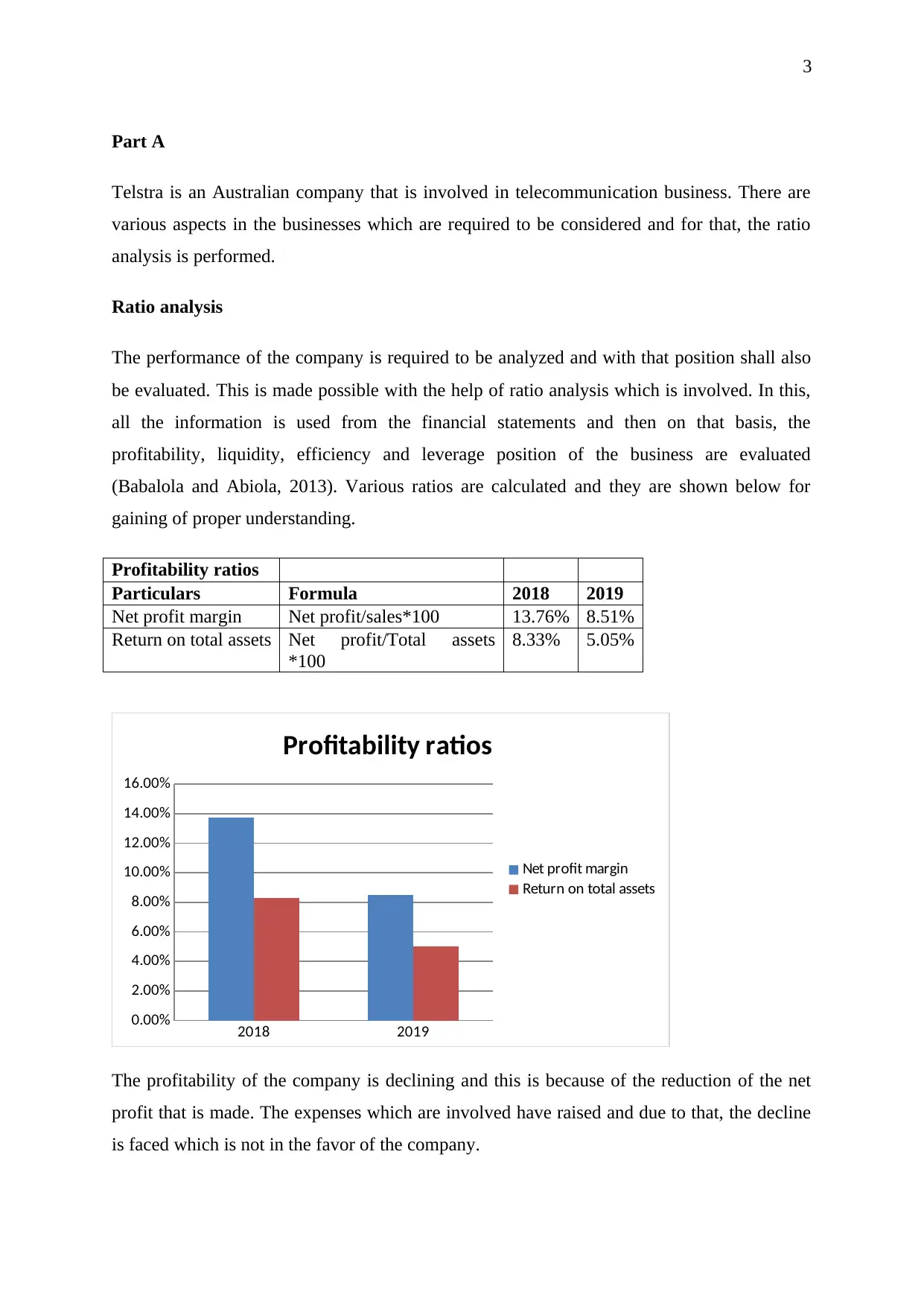
3
Part A
Telstra is an Australian company that is involved in telecommunication business. There are
various aspects in the businesses which are required to be considered and for that, the ratio
analysis is performed.
Ratio analysis
The performance of the company is required to be analyzed and with that position shall also
be evaluated. This is made possible with the help of ratio analysis which is involved. In this,
all the information is used from the financial statements and then on that basis, the
profitability, liquidity, efficiency and leverage position of the business are evaluated
(Babalola and Abiola, 2013). Various ratios are calculated and they are shown below for
gaining of proper understanding.
Profitability ratios
Particulars Formula 2018 2019
Net profit margin Net profit/sales*100 13.76% 8.51%
Return on total assets Net profit/Total assets
*100
8.33% 5.05%
2018 2019
0.00%
2.00%
4.00%
6.00%
8.00%
10.00%
12.00%
14.00%
16.00%
Profitability ratios
Net profit margin
Return on total assets
The profitability of the company is declining and this is because of the reduction of the net
profit that is made. The expenses which are involved have raised and due to that, the decline
is faced which is not in the favor of the company.
Part A
Telstra is an Australian company that is involved in telecommunication business. There are
various aspects in the businesses which are required to be considered and for that, the ratio
analysis is performed.
Ratio analysis
The performance of the company is required to be analyzed and with that position shall also
be evaluated. This is made possible with the help of ratio analysis which is involved. In this,
all the information is used from the financial statements and then on that basis, the
profitability, liquidity, efficiency and leverage position of the business are evaluated
(Babalola and Abiola, 2013). Various ratios are calculated and they are shown below for
gaining of proper understanding.
Profitability ratios
Particulars Formula 2018 2019
Net profit margin Net profit/sales*100 13.76% 8.51%
Return on total assets Net profit/Total assets
*100
8.33% 5.05%
2018 2019
0.00%
2.00%
4.00%
6.00%
8.00%
10.00%
12.00%
14.00%
16.00%
Profitability ratios
Net profit margin
Return on total assets
The profitability of the company is declining and this is because of the reduction of the net
profit that is made. The expenses which are involved have raised and due to that, the decline
is faced which is not in the favor of the company.
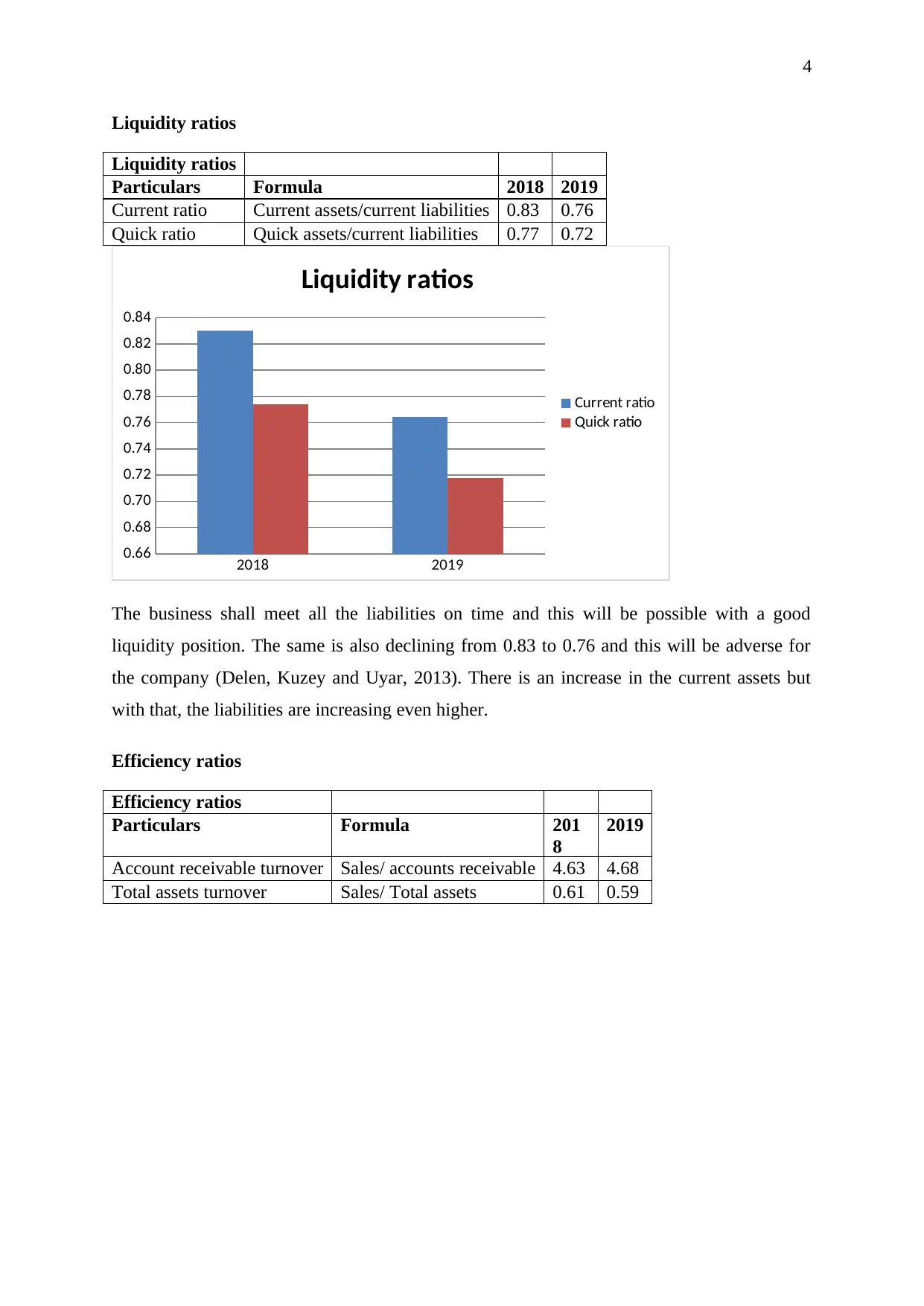
4
Liquidity ratios
Liquidity ratios
Particulars Formula 2018 2019
Current ratio Current assets/current liabilities 0.83 0.76
Quick ratio Quick assets/current liabilities 0.77 0.72
2018 2019
0.66
0.68
0.70
0.72
0.74
0.76
0.78
0.80
0.82
0.84
Liquidity ratios
Current ratio
Quick ratio
The business shall meet all the liabilities on time and this will be possible with a good
liquidity position. The same is also declining from 0.83 to 0.76 and this will be adverse for
the company (Delen, Kuzey and Uyar, 2013). There is an increase in the current assets but
with that, the liabilities are increasing even higher.
Efficiency ratios
Efficiency ratios
Particulars Formula 201
8
2019
Account receivable turnover Sales/ accounts receivable 4.63 4.68
Total assets turnover Sales/ Total assets 0.61 0.59
Liquidity ratios
Liquidity ratios
Particulars Formula 2018 2019
Current ratio Current assets/current liabilities 0.83 0.76
Quick ratio Quick assets/current liabilities 0.77 0.72
2018 2019
0.66
0.68
0.70
0.72
0.74
0.76
0.78
0.80
0.82
0.84
Liquidity ratios
Current ratio
Quick ratio
The business shall meet all the liabilities on time and this will be possible with a good
liquidity position. The same is also declining from 0.83 to 0.76 and this will be adverse for
the company (Delen, Kuzey and Uyar, 2013). There is an increase in the current assets but
with that, the liabilities are increasing even higher.
Efficiency ratios
Efficiency ratios
Particulars Formula 201
8
2019
Account receivable turnover Sales/ accounts receivable 4.63 4.68
Total assets turnover Sales/ Total assets 0.61 0.59
Secure Best Marks with AI Grader
Need help grading? Try our AI Grader for instant feedback on your assignments.
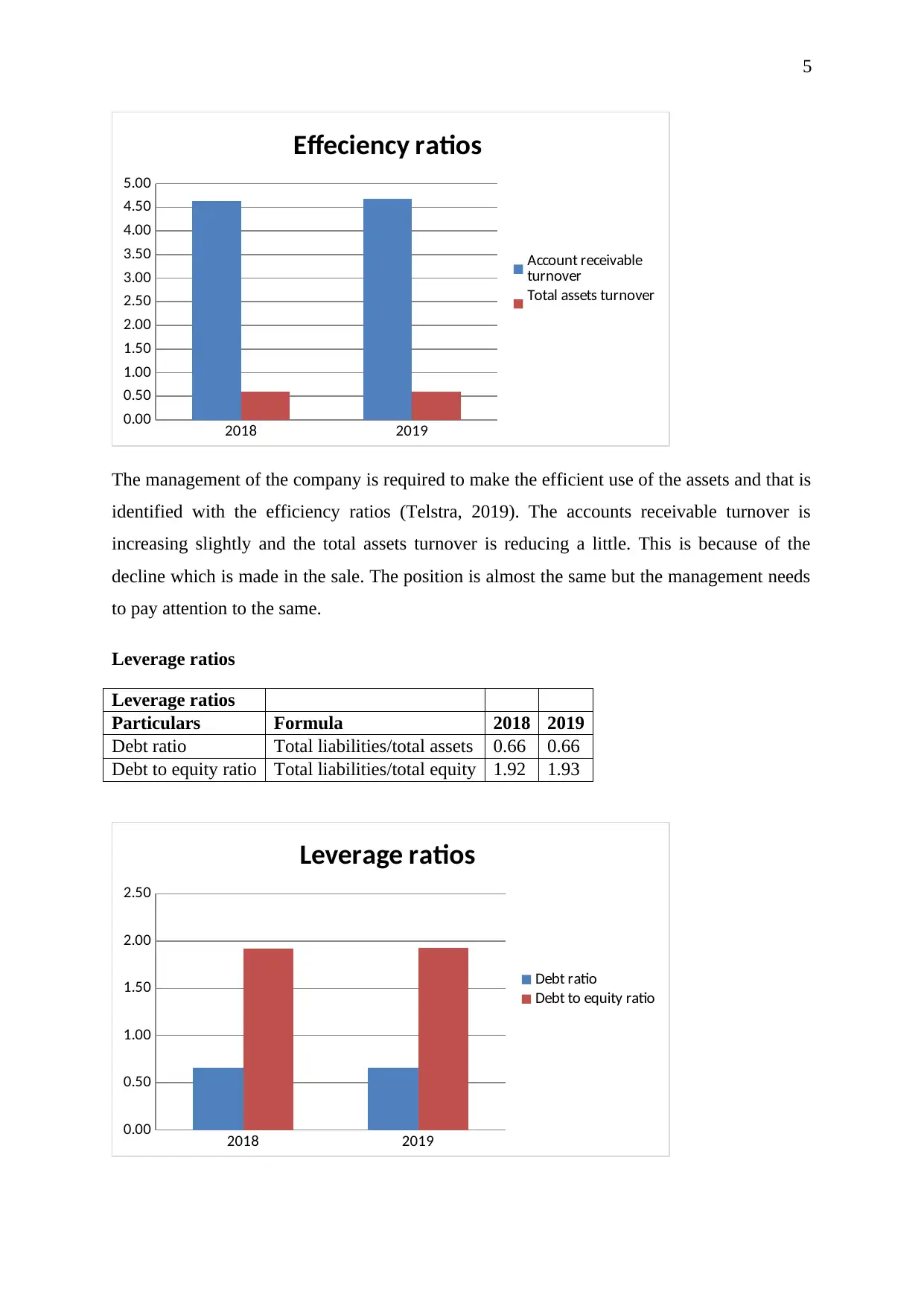
5
2018 2019
0.00
0.50
1.00
1.50
2.00
2.50
3.00
3.50
4.00
4.50
5.00
Effeciency ratios
Account receivable
turnover
Total assets turnover
The management of the company is required to make the efficient use of the assets and that is
identified with the efficiency ratios (Telstra, 2019). The accounts receivable turnover is
increasing slightly and the total assets turnover is reducing a little. This is because of the
decline which is made in the sale. The position is almost the same but the management needs
to pay attention to the same.
Leverage ratios
Leverage ratios
Particulars Formula 2018 2019
Debt ratio Total liabilities/total assets 0.66 0.66
Debt to equity ratio Total liabilities/total equity 1.92 1.93
2018 2019
0.00
0.50
1.00
1.50
2.00
2.50
Leverage ratios
Debt ratio
Debt to equity ratio
2018 2019
0.00
0.50
1.00
1.50
2.00
2.50
3.00
3.50
4.00
4.50
5.00
Effeciency ratios
Account receivable
turnover
Total assets turnover
The management of the company is required to make the efficient use of the assets and that is
identified with the efficiency ratios (Telstra, 2019). The accounts receivable turnover is
increasing slightly and the total assets turnover is reducing a little. This is because of the
decline which is made in the sale. The position is almost the same but the management needs
to pay attention to the same.
Leverage ratios
Leverage ratios
Particulars Formula 2018 2019
Debt ratio Total liabilities/total assets 0.66 0.66
Debt to equity ratio Total liabilities/total equity 1.92 1.93
2018 2019
0.00
0.50
1.00
1.50
2.00
2.50
Leverage ratios
Debt ratio
Debt to equity ratio
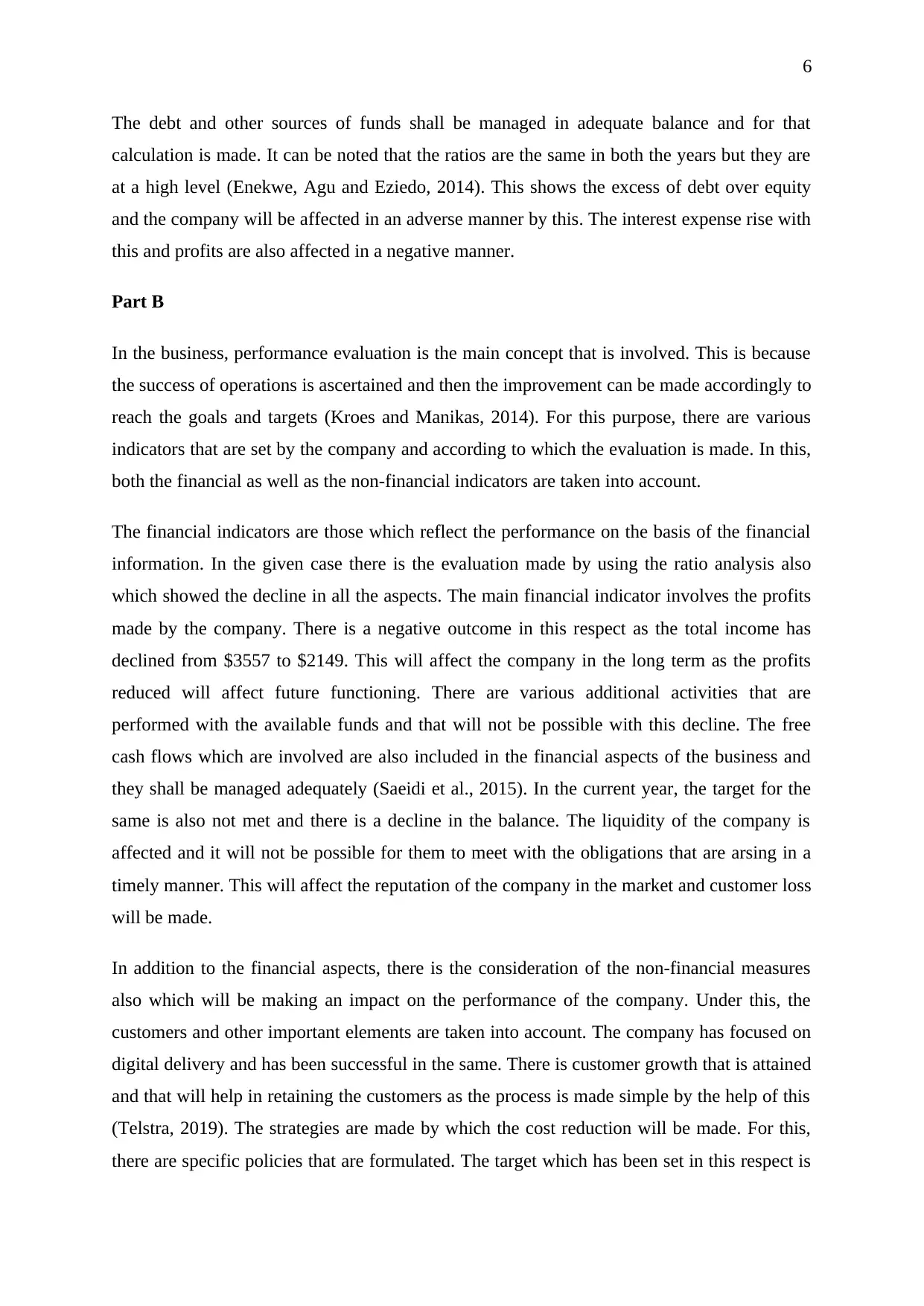
6
The debt and other sources of funds shall be managed in adequate balance and for that
calculation is made. It can be noted that the ratios are the same in both the years but they are
at a high level (Enekwe, Agu and Eziedo, 2014). This shows the excess of debt over equity
and the company will be affected in an adverse manner by this. The interest expense rise with
this and profits are also affected in a negative manner.
Part B
In the business, performance evaluation is the main concept that is involved. This is because
the success of operations is ascertained and then the improvement can be made accordingly to
reach the goals and targets (Kroes and Manikas, 2014). For this purpose, there are various
indicators that are set by the company and according to which the evaluation is made. In this,
both the financial as well as the non-financial indicators are taken into account.
The financial indicators are those which reflect the performance on the basis of the financial
information. In the given case there is the evaluation made by using the ratio analysis also
which showed the decline in all the aspects. The main financial indicator involves the profits
made by the company. There is a negative outcome in this respect as the total income has
declined from $3557 to $2149. This will affect the company in the long term as the profits
reduced will affect future functioning. There are various additional activities that are
performed with the available funds and that will not be possible with this decline. The free
cash flows which are involved are also included in the financial aspects of the business and
they shall be managed adequately (Saeidi et al., 2015). In the current year, the target for the
same is also not met and there is a decline in the balance. The liquidity of the company is
affected and it will not be possible for them to meet with the obligations that are arsing in a
timely manner. This will affect the reputation of the company in the market and customer loss
will be made.
In addition to the financial aspects, there is the consideration of the non-financial measures
also which will be making an impact on the performance of the company. Under this, the
customers and other important elements are taken into account. The company has focused on
digital delivery and has been successful in the same. There is customer growth that is attained
and that will help in retaining the customers as the process is made simple by the help of this
(Telstra, 2019). The strategies are made by which the cost reduction will be made. For this,
there are specific policies that are formulated. The target which has been set in this respect is
The debt and other sources of funds shall be managed in adequate balance and for that
calculation is made. It can be noted that the ratios are the same in both the years but they are
at a high level (Enekwe, Agu and Eziedo, 2014). This shows the excess of debt over equity
and the company will be affected in an adverse manner by this. The interest expense rise with
this and profits are also affected in a negative manner.
Part B
In the business, performance evaluation is the main concept that is involved. This is because
the success of operations is ascertained and then the improvement can be made accordingly to
reach the goals and targets (Kroes and Manikas, 2014). For this purpose, there are various
indicators that are set by the company and according to which the evaluation is made. In this,
both the financial as well as the non-financial indicators are taken into account.
The financial indicators are those which reflect the performance on the basis of the financial
information. In the given case there is the evaluation made by using the ratio analysis also
which showed the decline in all the aspects. The main financial indicator involves the profits
made by the company. There is a negative outcome in this respect as the total income has
declined from $3557 to $2149. This will affect the company in the long term as the profits
reduced will affect future functioning. There are various additional activities that are
performed with the available funds and that will not be possible with this decline. The free
cash flows which are involved are also included in the financial aspects of the business and
they shall be managed adequately (Saeidi et al., 2015). In the current year, the target for the
same is also not met and there is a decline in the balance. The liquidity of the company is
affected and it will not be possible for them to meet with the obligations that are arsing in a
timely manner. This will affect the reputation of the company in the market and customer loss
will be made.
In addition to the financial aspects, there is the consideration of the non-financial measures
also which will be making an impact on the performance of the company. Under this, the
customers and other important elements are taken into account. The company has focused on
digital delivery and has been successful in the same. There is customer growth that is attained
and that will help in retaining the customers as the process is made simple by the help of this
(Telstra, 2019). The strategies are made by which the cost reduction will be made. For this,
there are specific policies that are formulated. The target which has been set in this respect is
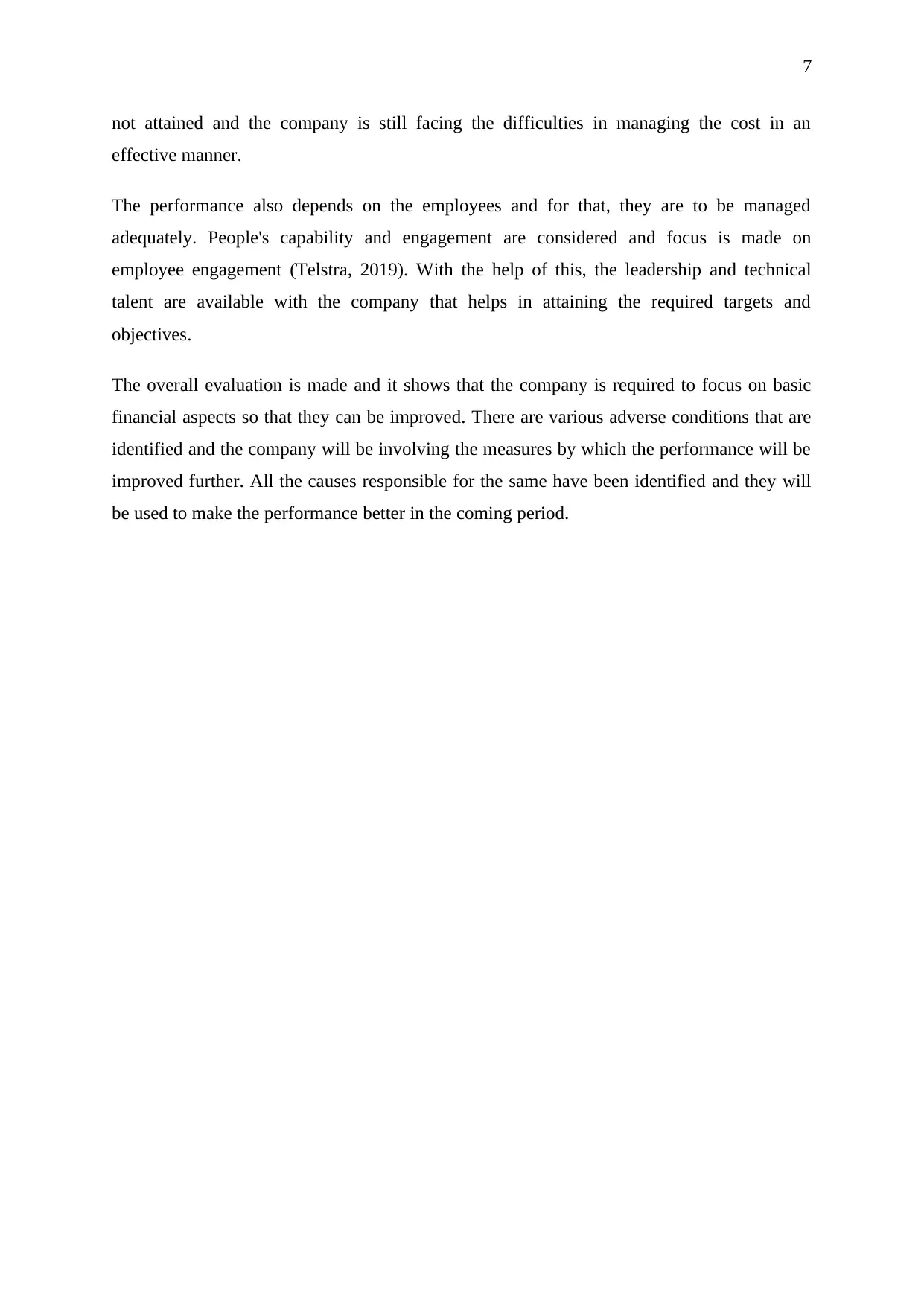
7
not attained and the company is still facing the difficulties in managing the cost in an
effective manner.
The performance also depends on the employees and for that, they are to be managed
adequately. People's capability and engagement are considered and focus is made on
employee engagement (Telstra, 2019). With the help of this, the leadership and technical
talent are available with the company that helps in attaining the required targets and
objectives.
The overall evaluation is made and it shows that the company is required to focus on basic
financial aspects so that they can be improved. There are various adverse conditions that are
identified and the company will be involving the measures by which the performance will be
improved further. All the causes responsible for the same have been identified and they will
be used to make the performance better in the coming period.
not attained and the company is still facing the difficulties in managing the cost in an
effective manner.
The performance also depends on the employees and for that, they are to be managed
adequately. People's capability and engagement are considered and focus is made on
employee engagement (Telstra, 2019). With the help of this, the leadership and technical
talent are available with the company that helps in attaining the required targets and
objectives.
The overall evaluation is made and it shows that the company is required to focus on basic
financial aspects so that they can be improved. There are various adverse conditions that are
identified and the company will be involving the measures by which the performance will be
improved further. All the causes responsible for the same have been identified and they will
be used to make the performance better in the coming period.
Paraphrase This Document
Need a fresh take? Get an instant paraphrase of this document with our AI Paraphraser
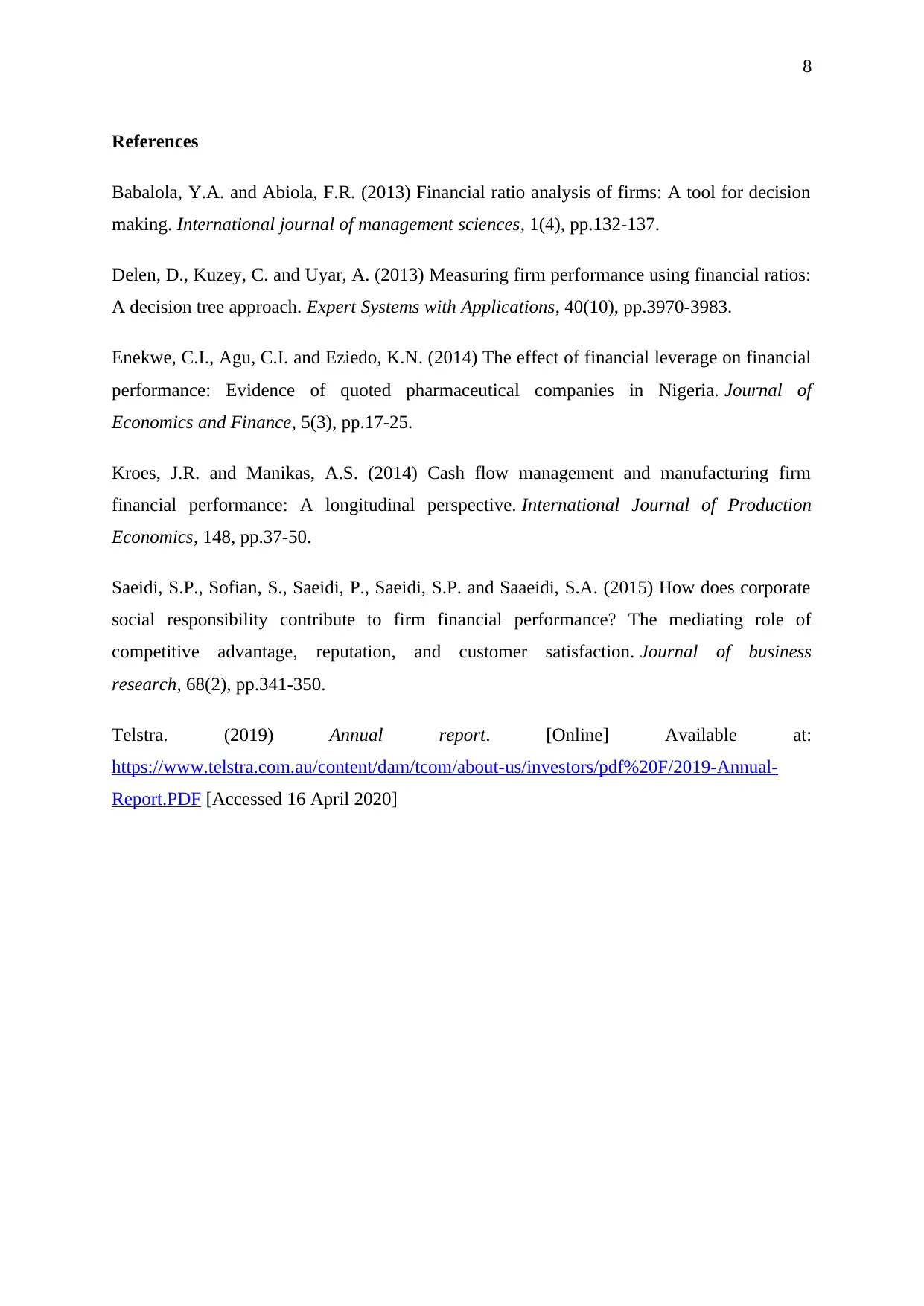
8
References
Babalola, Y.A. and Abiola, F.R. (2013) Financial ratio analysis of firms: A tool for decision
making. International journal of management sciences, 1(4), pp.132-137.
Delen, D., Kuzey, C. and Uyar, A. (2013) Measuring firm performance using financial ratios:
A decision tree approach. Expert Systems with Applications, 40(10), pp.3970-3983.
Enekwe, C.I., Agu, C.I. and Eziedo, K.N. (2014) The effect of financial leverage on financial
performance: Evidence of quoted pharmaceutical companies in Nigeria. Journal of
Economics and Finance, 5(3), pp.17-25.
Kroes, J.R. and Manikas, A.S. (2014) Cash flow management and manufacturing firm
financial performance: A longitudinal perspective. International Journal of Production
Economics, 148, pp.37-50.
Saeidi, S.P., Sofian, S., Saeidi, P., Saeidi, S.P. and Saaeidi, S.A. (2015) How does corporate
social responsibility contribute to firm financial performance? The mediating role of
competitive advantage, reputation, and customer satisfaction. Journal of business
research, 68(2), pp.341-350.
Telstra. (2019) Annual report. [Online] Available at:
https://www.telstra.com.au/content/dam/tcom/about-us/investors/pdf%20F/2019-Annual-
Report.PDF [Accessed 16 April 2020]
References
Babalola, Y.A. and Abiola, F.R. (2013) Financial ratio analysis of firms: A tool for decision
making. International journal of management sciences, 1(4), pp.132-137.
Delen, D., Kuzey, C. and Uyar, A. (2013) Measuring firm performance using financial ratios:
A decision tree approach. Expert Systems with Applications, 40(10), pp.3970-3983.
Enekwe, C.I., Agu, C.I. and Eziedo, K.N. (2014) The effect of financial leverage on financial
performance: Evidence of quoted pharmaceutical companies in Nigeria. Journal of
Economics and Finance, 5(3), pp.17-25.
Kroes, J.R. and Manikas, A.S. (2014) Cash flow management and manufacturing firm
financial performance: A longitudinal perspective. International Journal of Production
Economics, 148, pp.37-50.
Saeidi, S.P., Sofian, S., Saeidi, P., Saeidi, S.P. and Saaeidi, S.A. (2015) How does corporate
social responsibility contribute to firm financial performance? The mediating role of
competitive advantage, reputation, and customer satisfaction. Journal of business
research, 68(2), pp.341-350.
Telstra. (2019) Annual report. [Online] Available at:
https://www.telstra.com.au/content/dam/tcom/about-us/investors/pdf%20F/2019-Annual-
Report.PDF [Accessed 16 April 2020]
1 out of 8
Related Documents
Your All-in-One AI-Powered Toolkit for Academic Success.
+13062052269
info@desklib.com
Available 24*7 on WhatsApp / Email
![[object Object]](/_next/static/media/star-bottom.7253800d.svg)
Unlock your academic potential
© 2024 | Zucol Services PVT LTD | All rights reserved.





